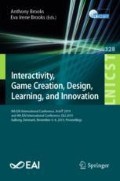Abstract
As virtual reality becomes more popular to be used in semi-public spaces such as museums and other exhibition venues, the question on how to optimally stage such an experience arises. To foster interaction between participants and bystanders, to lower the primary threshold in regards to participation and to moderate the transition between real and virtual worlds we propose to augment a virtual hot-air balloon ride by a large scale floor projection in addition to a physical basket and other extras. Exhibited at a venue in Stuttgart, Germany a total of 140 participants evaluated our approach. We could confirm that adding a floor projection helped to attract additional users, to increased the overall motivation on using the installation, and to established a connection between the real and the virtual worlds.
Access this chapter
Tax calculation will be finalised at checkout
Purchases are for personal use only
Notes
- 1.
When only seeing a person wearing a HMD in a semi-public space as a passer-by, one does not directly know what to expect from the upcoming experience and this might scare off (timid) visitors.
- 2.
See: https://www.medien.ifi.lmu.de/socialHMD/ for more information.
- 3.
When talking about immersive VR we only consider VR using HMDs in the context of this publication.
- 4.
References
Global Augmented/Virtual Reality market size 2016–2023 \(\vert \) Statista. https://www.statista.com/statistics/591181/global-augmented-virtual-reality-market-size (2019). Accessed 7 Oct 2019
Brignull, H., Rogers, Y.: Enticing people to interact with large public displays in public spaces. In: Proceedings of INTERACT, vol. 3, pp. 17–24 (2003)
Chan, L., Minamizawa, K.: Frontface: Facilitating communication between hmd users and outsiders using front-facing-screen hmds. In: Proceedings of the 19th International Conference on Human-Computer Interaction with Mobile Devices and Services, MobileHCI 2017, pp. 22:1–22:5. ACM, New York (2017)
Gugenheimer, J., Mai, C., McGill, M., Williamson, J., Steinicke, F., Perlin, K.: Challenges using head-mounted displays in shared and social spaces. In: Extended Abstracts of the 2019 CHI Conference on Human Factors in Computing Systems, CHI EA 2019, pp. W19:1–W19:8. ACM, New York (2019)
Gugenheimer, J., Stemasov, E., Frommel, J., Rukzio, E.: Sharevr: Enabling co-located experiences for virtual reality between hmd and non-hmd users. In: Proceedings of the 2017 CHI Conference on Human Factors in Computing Systems, pp. 4021–4033. ACM (2017)
Hepperle, D., Wölfel, M.: Do you feel what you see? Multimodal perception in virtual reality. In: Proceedings of the 23rd ACM Symposium on Virtual Reality Software and Technology, VRST 2017, pp. 56:1–56:2. ACM, New York (2017)
Hoffman, H.G.: Physically touching virtual objects using tactile augmentation enhances the realism of virtual environments. In: Proceedings of IEEE 1998 Virtual Reality Annual International Symposium (Cat. No.98CB36180), pp. 59–63 (1998)
Insko, B.E.: Passive haptics significantly enhances virtual environments. Ph.D. thesis (2001)
Ishii, A., Suzuki, I., Tsuruta, M., Nakamae, S., Suzuki, J., Ochiai, Y.: Reversecave: Cave-based visualization methods of public VR towards shareable VR experience. In: Extended Abstracts of the 2018 CHI Conference on Human Factors in Computing Systems, p. VS01. ACM (2018)
Lazar, J., Feng, J., Hochheiser, H.: Research Methods in Human-Computer Interaction. Elsevier Science, Cambridge (2017)
Mai, C., Khamis, M.: Public HMDs: Modeling and understanding user behavior around public head-mounted displays. In: Proceedings of the 7th ACM International Symposium on Pervasive Displays, PerDis 2018, pp. 21:1–21:9. ACM, New York (2018)
Mai, C., Wiltzius, T., Alt, F., Hussmann, H.: Feeling alone in public: Investigating the influence of spatial layout on users’ VR experience. In: Proceedings of the 10th Nordic Conference on Human-Computer Interaction, NordiCHI 2018, pp. 286–298. ACM, New York (2018)
Mancini, M.: Pictures at an exposition. Film Comment 19(1), 43 (1983)
Pantile, D., Frasca, R., Mazzeo, A., Ventrella, M., Verreschi, G.: New technologies and tools for immersive and engaging visitor experiences in museums: The evolution of the visit-actor in next-generation storytelling, through augmented and virtual reality, and immersive 3d projections. In: 2016 12th International Conference on Signal-Image Technology Internet-Based Systems (SITIS), pp. 463–467 (2016)
Siess, A., Beuck, S., Wölfel, M.: Virtual Reality-Quo Vadis? How to address the complete audience of an emerging technology. In: Collaborative European Research Conference, pp. 245–247 (2017)
Siess, A., Hepperle, D., Wölfel, M., Johansson, M.: Worldmaking: Designing for audience participation, immersion and interaction in virtual and real spaces. In: Brooks, A.L., Brooks, E., Sylla, C. (eds.) ArtsIT/DLI -2018. LNICSSITE, vol. 265, pp. 58–68. Springer, Cham (2019). https://doi.org/10.1007/978-3-030-06134-0_7
Sundén, E., Lundgren, I., Ynnerman, A.: Hybrid virtual reality touch table - An immersive collaborative platform for public explanatory use of cultural objects and sites. In: Schreck, T., Weyrich, T., Sablatnig, R., Stular, B. (eds.) Eurographics Workshop on Graphics and Cultural Heritage. The Eurographics Association (2017)
Author information
Authors and Affiliations
Corresponding author
Editor information
Editors and Affiliations
Rights and permissions
Copyright information
© 2020 ICST Institute for Computer Sciences, Social Informatics and Telecommunications Engineering
About this paper
Cite this paper
Hepperle, D., Siess, A., Wölfel, M. (2020). Staging Virtual Reality Exhibits for Bystander Involvement in Semi-public Spaces. In: Brooks, A., Brooks, E. (eds) Interactivity, Game Creation, Design, Learning, and Innovation. ArtsIT DLI 2019 2019. Lecture Notes of the Institute for Computer Sciences, Social Informatics and Telecommunications Engineering, vol 328. Springer, Cham. https://doi.org/10.1007/978-3-030-53294-9_18
Download citation
DOI: https://doi.org/10.1007/978-3-030-53294-9_18
Published:
Publisher Name: Springer, Cham
Print ISBN: 978-3-030-53293-2
Online ISBN: 978-3-030-53294-9
eBook Packages: Computer ScienceComputer Science (R0)

